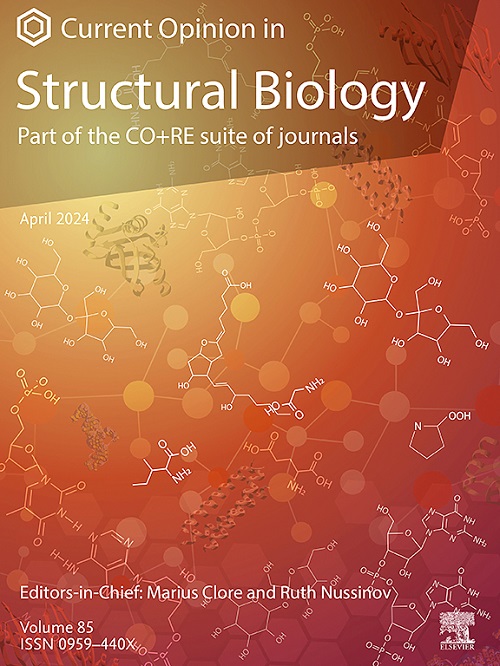Characterization of conformationally heterogeneous proteins by electron paramagnetic resonance spectroscopy
IF 6.1
2区 生物学
Q1 BIOCHEMISTRY & MOLECULAR BIOLOGY
引用次数: 0
Abstract
The Anfinsen paradigm of representing a protein by a single conformer is challenged by the uncertainty predictions that come with AlphaFold models, which suggest a greater extent of disorder. Characterization of such conformation heterogeneity requires experimental approaches that do not depend on long-range order. Site-directed spin labeling (SDSL) coupled with electron paramagnetic resonance (EPR) spectroscopy is such an approach. The double electron–electron resonance (DEER) technique can access site-pair distance distributions in the 15–100 Å range, directly informing on ensemble width. SDSL-EPR can be applied in cellular environments, and recent work indicates that protein disorder is even more pervasive than predicted by AlphaFold. This suggests that the Anfinsen paradigm should be replaced by an ensemble paradigm.

电子顺磁共振波谱法表征异质蛋白质构象
用单个构象来表示蛋白质的Anfinsen范式受到了AlphaFold模型带来的不确定性预测的挑战,该模型表明存在更大程度的紊乱。这种构象异质性的表征需要不依赖于远程顺序的实验方法。定点自旋标记(SDSL)与电子顺磁共振(EPR)光谱相结合就是这样一种方法。双电子-电子共振(DEER)技术可以获得15-100 Å范围内的位对距离分布,直接告知系集合宽度。SDSL-EPR可以应用于细胞环境,最近的研究表明,蛋白质紊乱甚至比AlphaFold预测的更为普遍。这表明安芬森范式应该被一个集成范式所取代。
本文章由计算机程序翻译,如有差异,请以英文原文为准。
求助全文
约1分钟内获得全文
求助全文
来源期刊

Current opinion in structural biology
生物-生化与分子生物学
CiteScore
12.20
自引率
2.90%
发文量
179
审稿时长
6-12 weeks
期刊介绍:
Current Opinion in Structural Biology (COSB) aims to stimulate scientifically grounded, interdisciplinary, multi-scale debate and exchange of ideas. It contains polished, concise and timely reviews and opinions, with particular emphasis on those articles published in the past two years. In addition to describing recent trends, the authors are encouraged to give their subjective opinion of the topics discussed.
In COSB, we help the reader by providing in a systematic manner:
1. The views of experts on current advances in their field in a clear and readable form.
2. Evaluations of the most interesting papers, annotated by experts, from the great wealth of original publications.
[...]
The subject of Structural Biology is divided into twelve themed sections, each of which is reviewed once a year. Each issue contains two sections, and the amount of space devoted to each section is related to its importance.
-Folding and Binding-
Nucleic acids and their protein complexes-
Macromolecular Machines-
Theory and Simulation-
Sequences and Topology-
New constructs and expression of proteins-
Membranes-
Engineering and Design-
Carbohydrate-protein interactions and glycosylation-
Biophysical and molecular biological methods-
Multi-protein assemblies in signalling-
Catalysis and Regulation
 求助内容:
求助内容: 应助结果提醒方式:
应助结果提醒方式:


